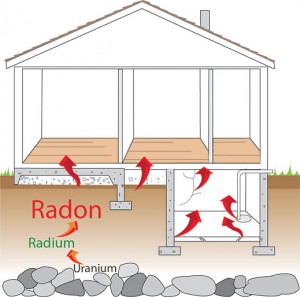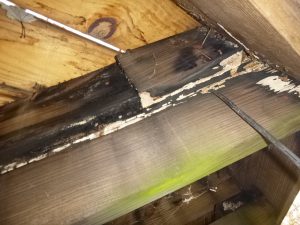Radon – 5 Common Myths About Testing
1. My home is built on a crawl space, I don’t need to test.
Homes built on a crawl space are just as vulnerable as a home with a basement. Like humans, Radon takes the path of least resistance and the negative air pressure (vacuum) within a home is typically what draws Radon into the living space . Radon concentrations under ground are not constant either. The amount of Radon below the surface may be substantial and whether the house is on a basement or a crawl space, elevated levels of Radon in the home are inevitable.
2. My home is built on a slab, I don’t need to test.
Homes built on a slab are no different than homes built on a crawl space or basement. As discussed in the last point about crawl spaces, it’s typically the negative air pressure (vacuum) in the home that draws the Radon into the living space. Any crack, pipe penetration, electrical penetration, or HVAC duct penetration in the slab is an entry point for Radon to enter.
3. All the homes in this neighborhood have tested below the action level. My home is probably fine.
Let’s assume you are checking the air pressure on your car tires. At this point you have only checked 3 of the tires and they were found to be within specifications. Do you assume the forth tire is at the correct pressure as the others? All 4 tires were installed at the same time by the same technician. All 4 tires have had the same amount of miles put on them. Reality is, you don’t know what the air pressure is until you check it. The choice is to either neglect the issue or have peace of mind knowing you are safe.
4. This home already has a mitigation system installed. We don’t need to test.
The process to properly mitigate a home is in depth and takes special knowledge. One of the techniques used to properly build a mitigation system for a basement is to seal all the penetrations in the concrete slab floor and seal the gap where the slab floor meets the foundation walls. Over time, if the home experiences settling and more cracks in the slab appear, or the previous owner installed a sump pump without properly sealing the penetration, the mitigation system may be ineffective or its effectiveness has been reduced. Another situation may arise on homes built on a crawl space with a mitigation system. PVC pipes are placed on the floor of the crawl space and are covered with a thick plastic vapor barrier. What happens is, Radon is trapped under the vapor barrier and sucked out through the PVC piping. The vapor barrier and piping system may become damaged by vermin or anyone servicing the crawl space. Damaging the vapor barrier reduces the mitigation systems effectiveness. In addition, Radon concentrations may vary over time and the EPA recommends testing every two years.
5. Our home tested below the action level when we moved in “x” years ago.
Radon entering the home is not constant. The concentration of Radon below the home can decrease or increase over time. Other variables such as wind, rain, and change in the seasons can increase the concentrations in the home. Like the inflated tire example we discussed earlier, assuming that the tire pressures have not changed since the time you checked it 6 months ago is neglect.



